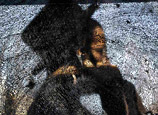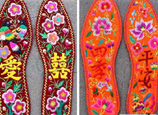
Oracle bone inscriptions
There were oracle bone inscriptions about an accident during a hunting activity of a Shang Dynasty king and divinatory results of eclipses.
The common practice was to drill holes and slots on oracle bones first, then burn these holes and slots with burning wood branches, and the flaw and patterns created would tell the divinatory results. The divinatory inscriptions would be carved near the flaws finally.
Turtle shell and ox scapula were the most commonly used materials at that time, Wang said.
Visitors to the exhibition will find the characters of Chinese Zodiac signs and other characters on oracle bones. Coming right back up-to-date, they are also able to play multimedia scapulimancy games of oracle bones.
So far, about 130,000 pieces of oracle bones have been found, with 4,000 characters found and 1,500 can be recognized. Most of the bones were excavated in Anyang.
At the beginning of the 14th century BC, King Pangeng of the Shang Dynasty established his capital two kilometers north of the city. The city, known as Yin, was the first stable capital in Chinese history.
The capital served 12 kings in eight generations until it was wiped out along with the dynasty that founded by King Wu of the Zhou in 1046 BC.
Bronze inscriptions, known as jin wen, is another type of early Chinese script which was represented by the inscriptions cast or etched on bronze objects of the West Zhou Dynasty (1046-771 BC). They mainly recorded ancient affairs about sacrificial ceremony, war and alliances.
A number of bronze vessel replicas and photographs are on display, as well as examples of style of bronze inscriptions and their strokes.
Written inscriptions cast in a bronze vessel of the West Zhou Dynasty recorded the success of King Wu in overthrowing the Shang Dynasty. The vessel used to store rice is the only historical remain of this major event.
Another wine vessel was cast with the name of Fu Hao, a wife of Shang king Wu Ding. There are also vessels made to offer sacrifices to ancestors by kings in the Shang Dynasty and vessels with written inscriptions serving as land transfer contracts in the West Zhou Dynasty, which are important historical documents of land policy at that time.
Inscriptions cast in a bronze vessel of the early West Zhou Dynasty recorded the experience of country governing.
 |  |














 Landmark building should respect the public's feeling
Landmark building should respect the public's feeling


![]()
